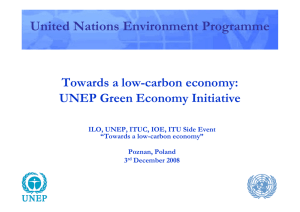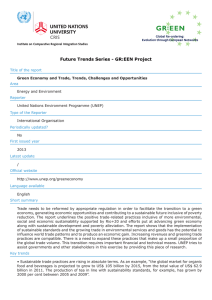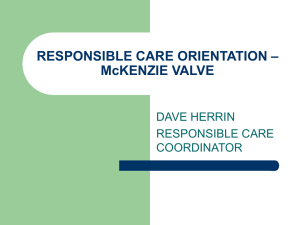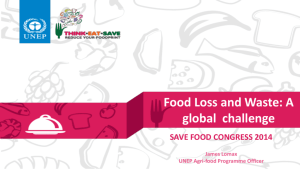On the Asian Brown Cloud controversy COMMENTARY J. Srinivasan and Sulochana Gadgil
advertisement
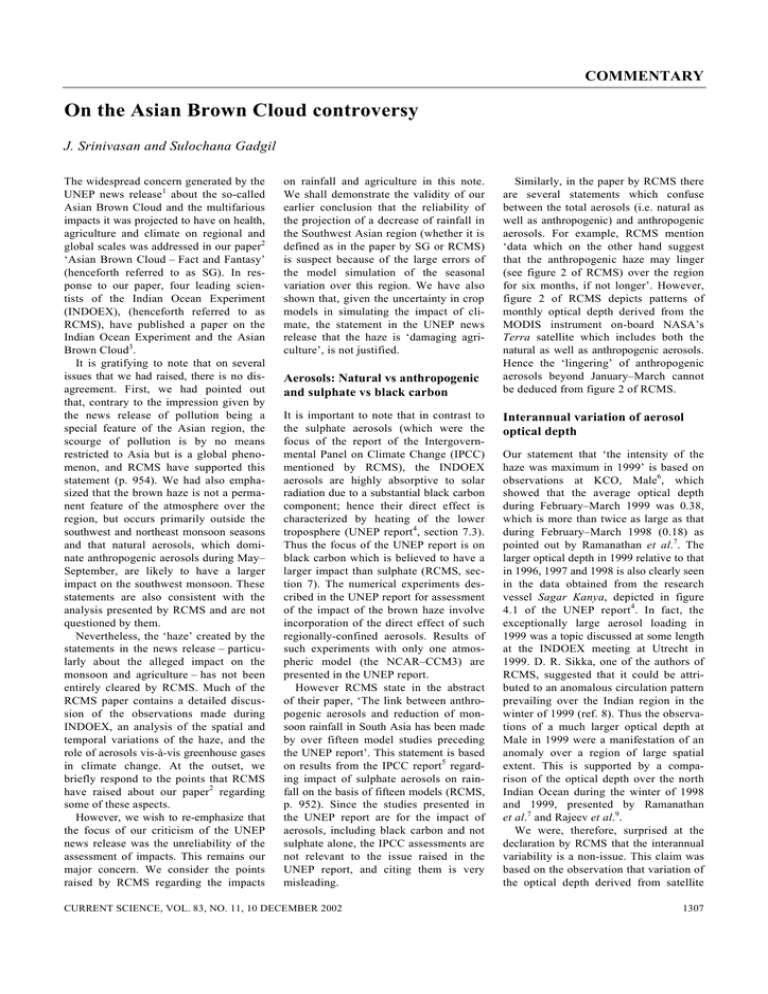
COMMENTARY On the Asian Brown Cloud controversy J. Srinivasan and Sulochana Gadgil The widespread concern generated by the UNEP news release1 about the so-called Asian Brown Cloud and the multifarious impacts it was projected to have on health, agriculture and climate on regional and global scales was addressed in our paper2 ‘Asian Brown Cloud – Fact and Fantasy’ (henceforth referred to as SG). In response to our paper, four leading scientists of the Indian Ocean Experiment (INDOEX), (henceforth referred to as RCMS), have published a paper on the Indian Ocean Experiment and the Asian Brown Cloud3. It is gratifying to note that on several issues that we had raised, there is no disagreement. First, we had pointed out that, contrary to the impression given by the news release of pollution being a special feature of the Asian region, the scourge of pollution is by no means restricted to Asia but is a global phenomenon, and RCMS have supported this statement (p. 954). We had also emphasized that the brown haze is not a permanent feature of the atmosphere over the region, but occurs primarily outside the southwest and northeast monsoon seasons and that natural aerosols, which dominate anthropogenic aerosols during May– September, are likely to have a larger impact on the southwest monsoon. These statements are also consistent with the analysis presented by RCMS and are not questioned by them. Nevertheless, the ‘haze’ created by the statements in the news release – particularly about the alleged impact on the monsoon and agriculture – has not been entirely cleared by RCMS. Much of the RCMS paper contains a detailed discussion of the observations made during INDOEX, an analysis of the spatial and temporal variations of the haze, and the role of aerosols vis-à-vis greenhouse gases in climate change. At the outset, we briefly respond to the points that RCMS have raised about our paper2 regarding some of these aspects. However, we wish to re-emphasize that the focus of our criticism of the UNEP news release was the unreliability of the assessment of impacts. This remains our major concern. We consider the points raised by RCMS regarding the impacts on rainfall and agriculture in this note. We shall demonstrate the validity of our earlier conclusion that the reliability of the projection of a decrease of rainfall in the Southwest Asian region (whether it is defined as in the paper by SG or RCMS) is suspect because of the large errors of the model simulation of the seasonal variation over this region. We have also shown that, given the uncertainty in crop models in simulating the impact of climate, the statement in the UNEP news release that the haze is ‘damaging agriculture’, is not justified. Aerosols: Natural vs anthropogenic and sulphate vs black carbon It is important to note that in contrast to the sulphate aerosols (which were the focus of the report of the Intergovernmental Panel on Climate Change (IPCC) mentioned by RCMS), the INDOEX aerosols are highly absorptive to solar radiation due to a substantial black carbon component; hence their direct effect is characterized by heating of the lower troposphere (UNEP report4, section 7.3). Thus the focus of the UNEP report is on black carbon which is believed to have a larger impact than sulphate (RCMS, section 7). The numerical experiments described in the UNEP report for assessment of the impact of the brown haze involve incorporation of the direct effect of such regionally-confined aerosols. Results of such experiments with only one atmospheric model (the NCAR–CCM3) are presented in the UNEP report. However RCMS state in the abstract of their paper, ‘The link between anthropogenic aerosols and reduction of monsoon rainfall in South Asia has been made by over fifteen model studies preceding the UNEP report’. This statement is based on results from the IPCC report5 regarding impact of sulphate aerosols on rainfall on the basis of fifteen models (RCMS, p. 952). Since the studies presented in the UNEP report are for the impact of aerosols, including black carbon and not sulphate alone, the IPCC assessments are not relevant to the issue raised in the UNEP report, and citing them is very misleading. CURRENT SCIENCE, VOL. 83, NO. 11, 10 DECEMBER 2002 Similarly, in the paper by RCMS there are several statements which confuse between the total aerosols (i.e. natural as well as anthropogenic) and anthropogenic aerosols. For example, RCMS mention ‘data which on the other hand suggest that the anthropogenic haze may linger (see figure 2 of RCMS) over the region for six months, if not longer’. However, figure 2 of RCMS depicts patterns of monthly optical depth derived from the MODIS instrument on-board NASA’s Terra satellite which includes both the natural as well as anthropogenic aerosols. Hence the ‘lingering’ of anthropogenic aerosols beyond January–March cannot be deduced from figure 2 of RCMS. Interannual variation of aerosol optical depth Our statement that ‘the intensity of the haze was maximum in 1999’ is based on observations at KCO, Male6, which showed that the average optical depth during February–March 1999 was 0.38, which is more than twice as large as that during February–March 1998 (0.18) as pointed out by Ramanathan et al.7. The larger optical depth in 1999 relative to that in 1996, 1997 and 1998 is also clearly seen in the data obtained from the research vessel Sagar Kanya, depicted in figure 4.1 of the UNEP report4. In fact, the exceptionally large aerosol loading in 1999 was a topic discussed at some length at the INDOEX meeting at Utrecht in 1999. D. R. Sikka, one of the authors of RCMS, suggested that it could be attributed to an anomalous circulation pattern prevailing over the Indian region in the winter of 1999 (ref. 8). Thus the observations of a much larger optical depth at Male in 1999 were a manifestation of an anomaly over a region of large spatial extent. This is supported by a comparison of the optical depth over the north Indian Ocean during the winter of 1998 and 1999, presented by Ramanathan et al.7 and Rajeev et al.9. We were, therefore, surprised at the declaration by RCMS that the interannual variability is a non-issue. This claim was based on the observation that variation of the optical depth derived from satellite 1307 COMMENTARY data, when integrated over the entire ocean basin north of the equator, was smaller than that at KCO, Male. This is only to be expected since the amplitude of variation of any quantity such as optical depth or rainfall generally decreases as the extent of the region over which the average is taken increases. That by itself cannot make the variation a non-issue. While discussing the impact of aerosols on the radiation budget, we considered the data at KCO, Male because continuous and accurate measurements of the radiation at the surface were available for periods exceeding one month only at that station. RCMS have stated that ‘the fundamental reason for SG’s contradicting conclusions is that they rely on data from one island station in the Maldives and from a five-day cruise in 2001, while the INDOEX estimates synthesize data from aircraft, ships, island stations with multiple satellites and include the entire region covered by the haze’. It is important to note that it is not possible to estimate surface forcing directly from satellite data. Hence derivation of the variation of surface forcing on the scale of the entire ocean basin north of the equator from satellite data involved extrapolation using the detailed observations at just one station, with some assumptions. This implies that if new observations at more stations suggest that some of the assumptions are not valid for some of the regions, the variation derived from satellite data will have to be modified. Thus, it is not clear whether the large-scale variation discussed by RCMS is more reliable than variation at the station at which detailed observations have been made. As far as the RCMS remark regarding the cruise in 2001 is concerned, it should be noted that the duration of the cruise was 22 days (and not five days as RCMS assert) and was comparable to the INDOEX cruises in 1996, 1997 and 1998. Also, the duration of the observations over the Arabian Sea during 2001 we referred to (p. 588 in SG) is comparable to the duration of the observations over that region in 1996, 1997 and 1998 (ref. 10), presented in figure 4.1 of the UNEP report4. ‘A vast blanket of pollution stretching across South Asia is damaging agriculture, modifying rainfall patterns including those of the mighty Monsoon . . . .’ Our point was simply that since the simulation results presented were only for the impact on the January to March season in the UNEP report, nothing could legitimately be said about the impact on the monsoon (southwest or northeast) from these results. We had further questioned the reliability of the assessment of the impact on the precipitation over the region to the northwest of India, as indicated by the statement in the UNEP news release2: ‘The global models used in the report suggest that the haze may reduce precipi- tation over Northwest India, Pakistan, Afghanistan, western China and the neighbouring western central Asian region by between 20 per cent and 40 per cent.’ Over the last two decades, climate models have been extensively used for prediction of impacts of enhancement of the concentration of greenhouse gases. A recognized expert in this area, with vast experience in the use of such models for impact assessments, has remarked, ‘Predictions from models will hold more conviction if they are shown to be capable of reproducing what is already happening’11. In our view, the assessment of impact on rainfall mentioned above (which is presented in the UNEP report4) was suspect because the simulation of Impact on precipitation We had suggested that there was little basis for the serious consequences of aerosols on the monsoon as projected in the UNEP news release1, viz. 1308 Figure 1. Variation of monthly mean rainfall (cm) in South West Asia from observations and CCM3 model simulations. The top figure is for the region as defined in the UNEP report (see ref. 4). The bottom figure is for the region as defined by Srinivasan and Gadgil (ref. 2). CURRENT SCIENCE, VOL. 83, NO. 11, 10 DECEMBER 2002 COMMENTARY rainfall in the region over which a marked reduction in rainfall was predicted, is particularly poor. This region lies between 40°–70°E and 15°–35°N (figures 6 and 7.5 UNEP report). Variation of the observed and the simulated monthly mean precipitation (derived from the AMIP run of the NCAR–CCM3 model; details in SG) averaged over the land points in this region was depicted in SG (figure 4 in SG). This is now compared in Figure 1 with the variation for the somewhat smaller region indicated as SW Asia by RCMS (defined as the region between 50°–65°E and 25°N–40°N). RCMS have pointed out that the magnitude of the error in simulation of the winter precipitation is smaller for the region they have chosen than for the region we had considered. They suggested that the discrepancies could be attributed to our choice of the region, which, they assume, had included most of the northern Arabian Sea. In fact, we had included only the land area. The difference in the magnitude of errors is thus due entirely to the difference in the spatial extent of the land regions considered. Of far greater importance than the magnitude of errors in winter precipitation, is the error in the simulation of the seasonal variation. It is seen from Figure 1 that the simulated pattern of seasonal variation is totally different from the observed pattern for either region. Thus, the observed rainfall is maximum in March and less than 1 cm/month in June, July and August. On the other hand, the simulated rainfall shows a major peak during July–August (when the rainfall is about fifteen times the observed value), with rainfall in the winter months being less than that observed. The seasonal variation of precipitation is mainly a response to the seasonal variation of the basic radiative heat source. Errors in the former, therefore, reflect in part, errors in the latter. It is clearly important to ensure that the response of the model to the basic variation in radiative heat source is realistic when the model is being used to derive the impact of perturbations in radiative heat sources brought about by factors such as aerosols. Errors in the simulation of the seasonal variation in the region over which a decrease in rainfall is predicted (or parts of that region such as the SW Asian region of RCMS) are clearly so large (Figure 1), that the reliability of the impact assessment is suspect. Impact on agriculture Assessments of the impact of the brown haze on the yield of some crops, including wheat and rice, based on the observational studies of the haze and the associated change in radiation with the help of crop models have also been presented in the UNEP report4. A decrease in the surface radiation by as much as 20% was shown to have almost no impact on the yield of wheat which is grown in the winter (Section 8.2.1, UNEP report4). We must note that less than 10% of the rice is grown in this season in India. The impact of the change in radiation on the simulated yield of rice varies from 2 to 10% for two sowing dates at the two locations considered, (Section 8.2.2, UNEP report4). We had pointed out that ‘when the impact of the haze on radiation as well as the weather is considered, the change in rice yield is 2% or less’ (SG, p. 592). This statement has not been disputed by RCMS. While assessing these projections, it is important to take into account the large uncertainty in the assessment of the impact with the use of crop models, as pointed out by Monteith and Ingram12. An instructive comparison of the simulation by models in the GCTE Rice network13 with observations at four rice-growing environments, showed that the difference between simulated and observed yields could be as large as 2.2 tons/ha, i.e. over 14%. Given such large uncertainties, and the small magnitude of the projected impact on yields for the Indian region for which the assessments are made, it is clear that the statement in the UNEP news release that ‘the vast blanket of pollution across South Asia is damaging agriculture’, is not justified. Thus, we conclude that the sensational statements implying dire consequences on the monsoon and agriculture in the UNEP news release are not justified and the reliability of the projected decrease of rainfall over SW Asia (by RCMS) is suspect. Concluding remarks Thus, on the question of impact, which was the major focus of our paper, we still disagree with RCMS; we find their assessments on rainfall and agriculture to be unreliable, although they state that they see no reason to modify these findings. CURRENT SCIENCE, VOL. 83, NO. 11, 10 DECEMBER 2002 We would like to endorse in strongest possible terms the view taken by IPCC that our level of scientific understanding of the impact of aerosols on climate is low. Hence, it is premature to make predictions that sound authoritative (with or without caveats) as regards the impact of anthropogenic aerosols on regional and global climate. In order to assess the impact of Asian Brown Haze on climate, it is essential that the high standards of rigorous assessment set by IPCC be adopted. This is particularly important since the projected impacts involve politically sensitive issues, such as pollution in one country leading to reduction in rainfall in another. 1. UNEP news release 2002/56. 2. Srinivasan, J. and Sulochana Gadgil, Curr. Sci., 2002, 83, 586–592. 3. Ramanathan, V., Crutzen, P. J., Mitra, A. P. and Sikka, D., ibid, 947– 955. 4. A UNEP Assessment Report based on findings from the Indian Ocean Experiment, Center for Clouds, Chemistry and Climate (C4), University of California, San Diego, 2002; available at www. rrcap.unep.org/abc/impactstudy/ 5. Climate Change, Scientific Basis, Intergovernmental Panel on Climate Change, Cambridge University Press, 2001. 6. Satheesh, S. K. and Ramanathan, V., Nature, 2000, 405, 60–63. 7. Ramanathan, V. et al., J. Geophys. Res., 2001, 106, 28371–28398. 8. Sikka, D. R., 2000, (pers. commun.). 9. Rajeev, K., Ramanathan, V. and Meywerk, J., J. Geophys. Res., 2000, 105, 2029– 2043. 10. Mitra, A. P., Curr. Sci. (Suppl.), 2001, 80, 3–6. 11. Mitchell, J. F. B., Davis, R. A., Ingram, W. J. and Senior C. A., J. Climate, 1995, 8, 2364–2386. 12. Monteith, J. L. and Ingram, J. S. I., in Second International Crop Science Congress, C3\I-R\CROP-SYM\PLENARY\ CROP-50P.PM4, 1996, pp. 57–70. 13. Ingram, J. S. I., Report of the GCTE Rice Network Experimentation Planning Workshop, Bangkok, GCTE Working Document 19, GCTE focus 3 Office, Oxford, UK, 1996. J. Srinivasan and Sulochana Gadgil are in the Centre for Atmospheric and Oceanic Sciences, Indian Institute of Science, Bangalore 560 012, India (e-mail: jayes@ caos.iisc.ernet.in). 1309

